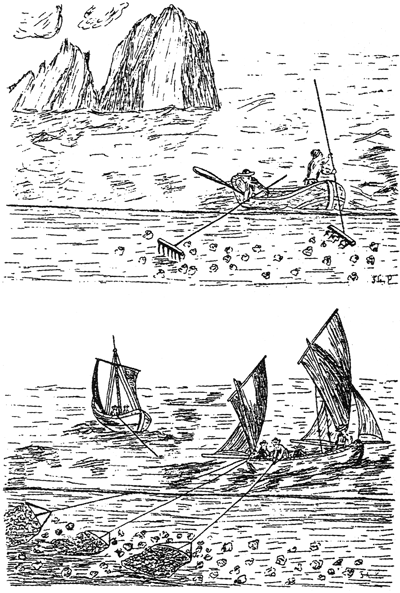
Scallop dredge
Encyclopedia

Dredge
Dredging is an excavation activity or operation usually carried out at least partly underwater, in shallow seas or fresh water areas with the purpose of gathering up bottom sediments and disposing of them at a different location...
which is towed along the bottom of the sea by a fishing boat in order to collect a targeted edible bottom-dwelling species. The gear is used to fish for scallop
Scallop
A scallop is a marine bivalve mollusk of the family Pectinidae. Scallops are a cosmopolitan family, found in all of the world's oceans. Many scallops are highly prized as a food source...
s, oyster
Oyster
The word oyster is used as a common name for a number of distinct groups of bivalve molluscs which live in marine or brackish habitats. The valves are highly calcified....
s and other species of clams
CLaMS
CLaMS is a modular chemistry transport model system developed at Forschungszentrum Jülich, Germany. CLaMS was first described by McKenna et al. and was expanded into three dimensions by Konopka et al....
, crabs, and sea cucumber
Sea cucumber (food)
Sea cucumbers are marine animals of the class Holothuroidea used in fresh or dried form in various cuisines.The creature and the food product is commonly known as bêche-de-mer in French, trepang in Indonesian, namako in Japanese and in the Philippines it is called balatan...
. The dredge is then winch
Winch
A winch is a mechanical device that is used to pull in or let out or otherwise adjust the "tension" of a rope or wire rope . In its simplest form it consists of a spool and attached hand crank. In larger forms, winches stand at the heart of machines as diverse as tow trucks, steam shovels and...
ed up into the boat and emptied.
The dredge is usually constructed from a heavy steel frame in the form of a scoop. The frame is covered with chain mesh which is open on the front side, which is towed. The chain mesh functions as a net
Fishing net
A fishing net or fishnet is a net that is used for fishing. Fishing nets are meshes usually formed by knotting a relatively thin thread. Modern nets are usually made of artificial polyamides like nylon, although nets of organic polyamides such as wool or silk thread were common until recently and...
.
Dredges may or may not have teeth along the bottom bar of the frame. In Europe, early dredges had teeth, called tynes, at the bottom. These teeth raked or ploughed the sand and mud, digging up buried clams. This design was improved by using spring-loaded teeth that reduced bottom snagging, and so could be used over rough ground. The New Bedford
New Bedford
-Places:*New Bedford, Illinois*New Bedford, Massachusetts, the most populous New Bedford**New Bedford Whaling National Historical Park*New Bedford, New Jersey *New Bedford, Ohio*New Bedford, Pennsylvania...
(USA) dredge does not have teeth.
Dredge nets have a coarse mesh in order to let organisms smaller than the target species through. The net catches the larger organisms: in the case of scallop dredging that includes the scallops' predators, such as whelk
Whelk
Whelk, also spelled welk or even "wilks", is a common name used to mean one or more kinds of sea snail. The species, genera and families referred to using this common name vary a great deal from one geographic area to another...
s, starfish and octopus
Octopus
The octopus is a cephalopod mollusc of the order Octopoda. Octopuses have two eyes and four pairs of arms, and like other cephalopods they are bilaterally symmetric. An octopus has a hard beak, with its mouth at the center point of the arms...
.
In some cases several dredges are attached to a wheeled rigid axle in groups of three or four. A number of these dredges can be towed from a heavy spreading bar, usually one from each side of the vessel. The length of the bar and number of dredges towed depends on the power of the vessel and the room on the side deck for working the dredges. The number might be 3 on each side on a small 10 metre boat up to 20 on each side for a 30 metre vessel with 1500 hp. The great weight and strength of the gear can disturb the ground it is towed over, overturning rocks and dislodging and crushing organisms in its path.
Scallop dredging tends to result in scallops containing grit, and can damage the seabed if done carelessly. So these days scallop dredging is often replaced by scuba diving
Scuba diving
Scuba diving is a form of underwater diving in which a diver uses a scuba set to breathe underwater....
. Like a better mouse trap, there is still a challenge for inventors to produce a kinder and more gentle scallop dredge.
See also
- Gathering scallops
- Gathering seafood by handGathering seafood by handGathering seafood by hand can be as easily as picking shellfish or kelp up off the beach, or doing some digging for clams or crabs, or perhaps diving under the water for abalone or lobsters....
- Oyster boats
- Solway HarvesterSolway HarvesterThe Solway Harvester is a scallop dredger from Kirkcudbright, Scotland which sank off the coast of Ramsey, Isle of Man in heavy storms on 11 January 2000. Following salvage, the damaged ship was taken to Douglas, Isle of Man, where she remains as of August 2011.-Career and sinking:The Solway...

